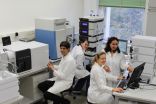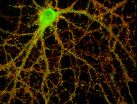Kung fu stegosaur
2014-10-21
(Press-News.org) Boulder, CO, USA — Stegosaurs might be portrayed as lumbering plant eaters, but they were lethal fighters when necessary, according to paleontologists who have uncovered new evidence of a casualty of stegosaurian combat. The evidence is a fatal stab wound in the pubis bone of a predatory allosaur. The wound – in the conical shape of a stegosaur tail spike – would have required great dexterity to inflict and shows clear signs of having cut short the allosaur's life.
"A massive infection ate away a baseball-sized sector of the bone," reports Houston Museum of Natural Science paleontologist Robert Bakker and his colleagues, who present a poster on the discovery on Tuesday at the meeting of the Geological Society of America in Vancouver, B.C. "Probably this infection spread upwards into the soft tissue attached here, the thigh muscles and adjacent intestines and reproductive organs." The lack of any signs of healing strongly suggests the allosaur died from the infection.
Similar wounds are seen in rodeo cowboys or horses when they are gored by longhorns, Bakker said. And since large herbivores – like longhorn cattle, rhinos and buffalo – today defend themselves with horns, it's reasonable to assume spiky herbivorous dinos did the same. A big difference is that stegosaurs wielded their weapon on their tails rather than their heads. Skeletal evidence from fossil stegosaurs suggests their tails were more dextrous than most dinosaur tails.
"They have no locking joints, even in the tail," Bakker explained. "Most dinosaur tails get stiffer towards the end." But stegosaurs had massive muscles at the base of the tails, flexibility and fine muscle control all the way to the tail tip. "The joints of a stegosaur tail look like a monkey's tail. They were built for 3-dimensional combat."
In order to deliver the mortal wound to the allosaur, a stegosaur would have had to sweep its tail under the allosaur and twist the tail tip, because normally the spikes point outward and backward. That would have been well within the ability of a stegosaur, Bakker said.
The fighting style and skill of stegosaurs should come as no surprise to anyone familiar with the dinosaur battle scene in the 1940 Disney animated film Fantasia, said Bakker. That segment of the movie shows a beefed up allosaur attacking a stegosaur. The stegosaur delivers a number of well aimed tail blows at the predator, but loses the fight. The Fantasia stegosaur tail dexterity appears to be accurate, he said. But he questions the stegosaur's loss in the end. "I think the stegosaur threw the fight," he said. On the other hand, he points out stegosaurs had among the smallest brains for its body size of any large animal, ever.
INFORMATION:
WHAT
Stegosaurian Martial Arts: A Jurassic Carnivore Stabbed by a Tail Spike, Evidence for Dynamic Interactions between a Live Herbivore and a Live Predator
Session No. 221 – Booth #247
Paleontology: New Discoveries in Vertebrate Trace and Body Fossils (Posters)
Abtract: https://gsa.confex.com/gsa/2014AM/webprogram/Paper247355.html
WHO
Robert T. Bakker
Department of Paleontology, Houston Museum of Natural Science, Houston, TX
Email: zorilla47@aol.com
WHERE & WHEN
Tuesday, 21 October 2014: 9:00 AM-6:30 PM
Vancouver Convention Centre-West Exhibition Hall C
PHOTOS AVAILABLE
The Geological Society of America, founded in 1888, is a scientific society with more than 26,500 members from academia, government, and industry in more than 100 countries. Through its meetings, publications, and programs, GSA enhances the professional growth of its members and promotes the geosciences in the service of humankind. Headquartered in Boulder, Colorado, GSA encourages cooperative research among earth, life, planetary, and social scientists, fosters public dialogue on geoscience issues, and supports all levels of earth science education.
ELSE PRESS RELEASES FROM THIS DATE:
2014-10-21
OAK RIDGE, Tenn., Oct. 21, 2014—Scientists at the Department of Energy's Oak Ridge National Laboratory have discovered exceptional properties in a garnet material that could enable development of higher-energy battery designs.
The ORNL-led team used scanning transmission electron microscopy to take an atomic-level look at a cubic garnet material called LLZO. The researchers found the material to be highly stable in a range of aqueous environments, making the compound a promising component in new battery configurations.
Researchers frequently seek to improve ...
2014-10-21
Boulder, CO, USA — Washington's coast is so close to the seismically active Cascadia Subduction Zone that if a megathrust earthquake were to occur, a tsunami would hit the Washington shoreline in just 25 minutes.
One coastal community is preparing for such a disaster by starting construction on the nation's first tsunami evacuation refuge, large enough to shelter more than 1,000 people who are within 20-minute walking distance.
The vertical evacuation-refuge will be the roof of the gym of the new school in Grays Harbor County, Washington. The Ocosta Elementary ...
2014-10-21
They may be tiny and stingless but there's nothing sweet and innocent about a species of native Sugarbag bee when it goes to war over a coveted honey-filled hive.
A study by behavioural ecologist Dr Paul Cunningham, from QUT, and molecular biologist Dr James Hereward, from the University of Queensland, published in American Naturalist, found the bees' used their jaws as lethal weapons when they zoomed in on a neighbouring Brisbane hive to boot out the inhabitants and install their own queen to rule.
Dr Cunningham said the attacking bees arrived in a swarm and clashed ...
2014-10-21
This news release is available in German. Stroma cells are derived from connective tissue and may critically influence tumour growth. This knowledge is not new. However, bioanalyst Christopher Gerner and an interdisciplinary team from the University of Vienna and the Medical University of Vienna have developed a novel methodology for investigation. Using modern mass spectrometry, tumour-promoting activities from breast fibroblasts were directly determined from needle biopsy samples. Recently this experimental break-through is published in the renowned Journal of Proteome ...
2014-10-21
Folsom, Calif., (October 21, 2014) – A new animal study published in the Journal of Alzheimer's Disease indicates that a diet including walnuts may have a beneficial effect in reducing the risk, delaying the onset, slowing the progression of, or preventing Alzheimer's disease.
Research led by Abha Chauhan, PhD, head of the Developmental Neuroscience Laboratory at the New York State Institute for Basic Research in Developmental Disabilities (IBR), found significant improvement in learning skills, memory, reducing anxiety, and motor development in mice fed a walnut-enriched ...
2014-10-21
When it comes to the brain, "more is better" seems like an obvious assumption. But in the case of synapses, which are the connections between brain cells, too many or too few can both disrupt brain function.
Researchers from Princeton University and the University of California-San Diego (UCSD) recently found that an immune-system protein called MHCI, or major histocompatibility complex class I, moonlights in the nervous system to help regulate the number of synapses, which transmit chemical and electrical signals between neurons. The researchers report in the Journal ...
2014-10-21
Massive black holes spewing out radio-frequency-emitting particles at near-light speed can block formation of new stars in aging galaxies, a study has found.
The research provides crucial new evidence that it is these jets of "radio-frequency feedback" streaming from mature galaxies' central black holes that prevent hot free gas from cooling and collapsing into baby stars.
"When you look into the past history of the universe, you see these galaxies building stars," said Tobias Marriage, assistant professor of physics and astronomy at Johns Hopkins and co-lead author ...
2014-10-21
A new medical imaging method being developed at Rutgers University could help physicians detect cancer and other diseases earlier than before, speeding treatment and reducing the need for invasive, time-consuming biopsies.
The potentially lifesaving technique uses nanotechnology to reveal small cancerous tumors and cardiovascular lesions deep inside the body. It is showing promise in early tests by Rutgers researchers in the schools of engineering and pharmacy.
The Rutgers scientists, who published initial results of their work in the July issue of the journal Nature ...
2014-10-21
Undescended testis is commonly found in newborn boys and usually normalizes spontaneously by the age of six months. In one in a hundred boys, however, at least one testis remains undescended—a condition associated with impaired fertility and a higher risk of testicular cancer in later life. About 3500 boys are affected with this condition in Germany each year. In the currently valid medical guideline for the treatment of undescended testis, early surgery is recommended, i.e., orchidopexy before the child's first birthday, in order to prevent late sequelae. Nonetheless, ...
2014-10-21
LAWRENCE — Whiplash the Cowboy Monkey. Grumpy Cat. "Peanut," the Ugliest Dog in the World. These might be a sampling of the most familiar animals to millions of users of social networking sites like Facebook.
But one doctoral student in geography at the University of Kansas recognizes social networking sites as a potential boon for scientifically documenting Earth's biodiversity, particularly in developing nations. In fact, for this idea, Vijay Barve was just honored with a Young Researchers Award from the Global Biodiversity Information Facility, an international ...
LAST 30 PRESS RELEASES:
[Press-News.org] Kung fu stegosaur



